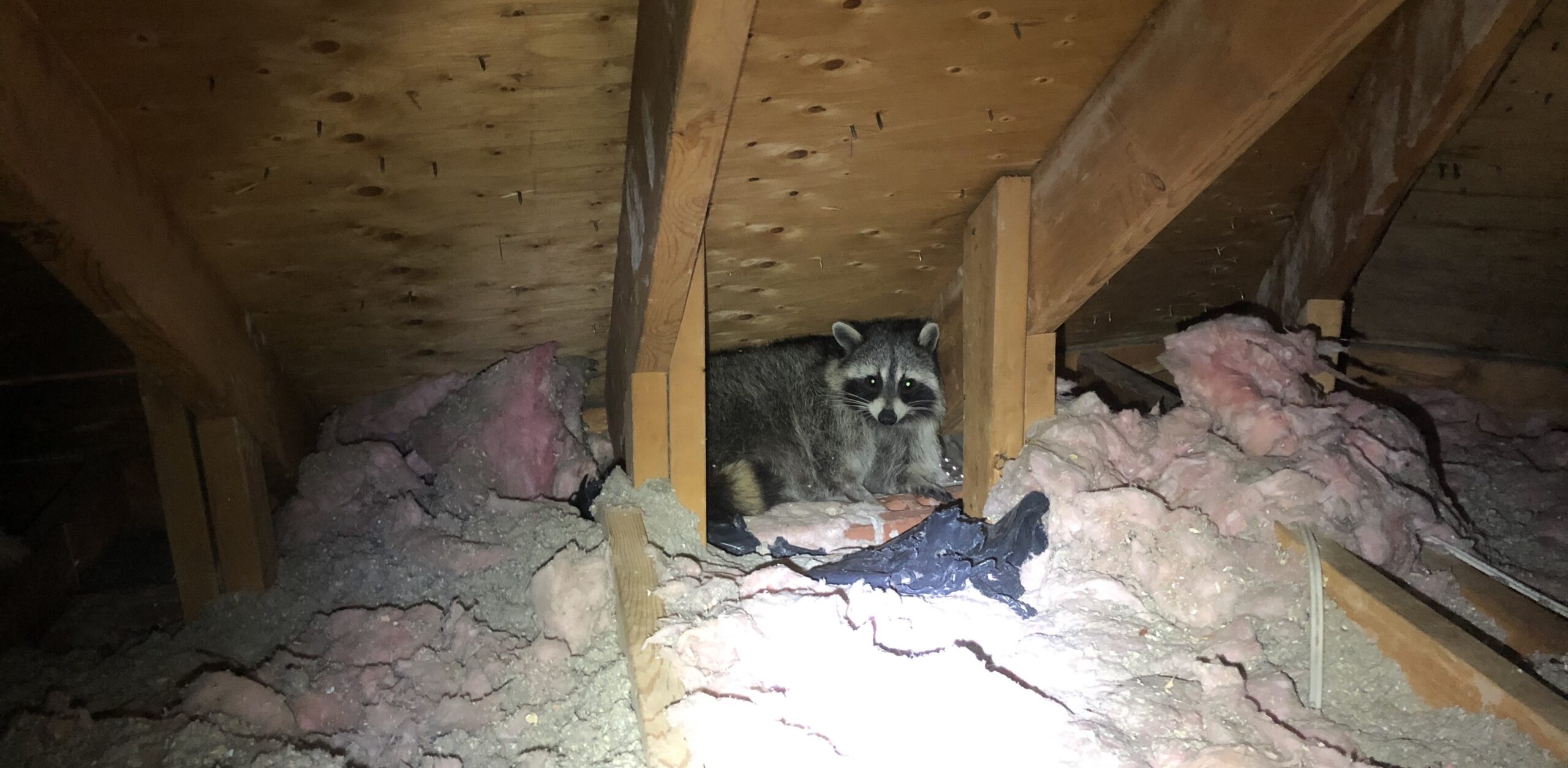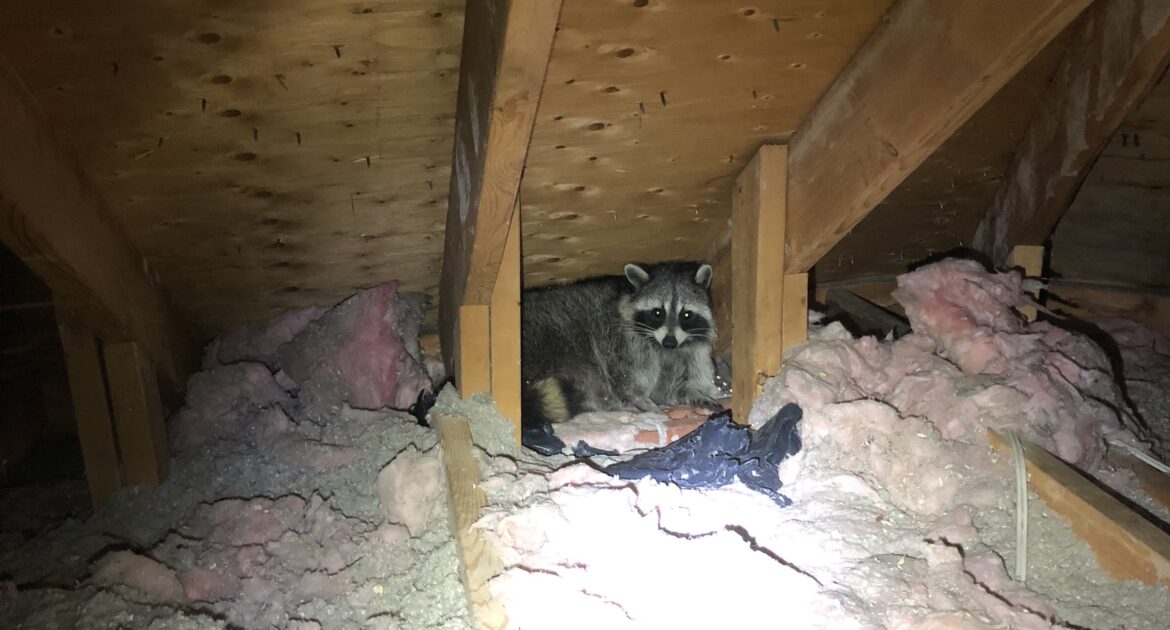If you’ve heard strange noises in your attic at night or noticed damage to your house, raccoons in your home could be the cause. These clever animals are known for finding inventive ways to make their homes in urban areas like London. With their adaptability and intelligence, they can turn any weak spot in your house into the perfect nesting spot. Knowing where they’re most likely to settle is key to protecting your home.
At Skedaddle Humane Wildlife Control, we’ve encountered raccoons nesting in some surprising places, and in this article, we’ll share the top spots they choose, what signs to look for, and how to keep them out.
1. Raccoon Nesting Spots in Attics
Attics are one of the most common places where raccoons settle. The quiet, dark, and enclosed environment provides the security raccoons need, especially for raising their babies. Roof access through loose shingles, roof vents, or soffits makes the attic an entry point of choice.
Why Attics Are Attractive to Raccoons:
- Warmth and Shelter: Especially during the winter months, raccoons seek warmth, and an attic’s insulation creates the perfect environment.
- Proximity to Food Sources: Attic openings often lead to homeowners’ backyards, where garbage bins or pet food might attract wildlife.
- Safe Place for Babies: Mother raccoons look for quiet spaces to have and raise their kits, and attics fit the bill perfectly.
How to Identify Raccoons in the Attic:
- Unusual Noises: Listen for scratching, scurrying, or thumping sounds, often heard at night.
- Foul Smell: Accumulated droppings can produce a strong, unpleasant smell.
- Damaged Insulation or Wiring: Raccoons may tear insulation apart or chew through wiring, potentially creating fire hazards.
- Visible Damage: Look for holes in the roof, bent soffits, or broken vents.
Preventing Attic Intrusions:
- Install heavy-duty screening over roof vents.
- Regularly inspect your roof for damage or weak points.
- Trim tree branches that hang over your roof to limit climbing access.
2. Raccoons in Chimneys
Chimneys mimic the hollow trees raccoons naturally use as dens, making them an appealing alternative in urban areas. The vertical structure provides protection from the elements and predators.
Indicators of a Raccoon in Your Chimney:
- Loud Chattering: Female raccoons often chatter while birthing or caring for their litters.
- Strong Odours: A significant build-up of droppings can cause a smell to seep into your home.
- Debris Falling Down: Chimneys occupied by raccoons may have pieces of insulation, leaves, or nesting materials scattered at the base.
Preventing Chimney Nesting:
- Install secure chimney caps to block entry.
- Repair any cracks or damage to the chimney’s exterior.
- Avoid letting debris accumulate near the base of the chimney.
While attics and chimneys are the most common nesting spots, raccoons can find refuge in other areas within your home. They are exceptionally resourceful and will use any accessible location to create a nest.
3. Wall Cavities and Crawl Spaces
Raccoons can squeeze through gaps as small as four inches, making wall cavities and crawl spaces potential nesting areas. These spots provide warmth and safety, but accessing them to remove unwanted guests can be a challenge. Look for signs like scratching noises or visible entry holes near the base of your home.
Basements
Though less common, raccoons can access poorly sealed basements by sneaking through foundation cracks or damaged basement doors. Once inside, they may damage belongings or leave droppings that compromise the air quality in the space.
Sheds and Garages
Outdoor structures like sheds and garages provide convenient shelter. If doors or walls have weak points, raccoons can easily slip in to establish a nest. Items like storage boxes or unused furniture often make these spaces cozy for nesting.
Tips to Protect Indoor Spaces:
- Seal gaps and cracks in exterior walls and foundations.
- Install sturdy doors and ensure they close tightly.
- Regularly inspect all indoor and outdoor storage areas.
Raccoons in London and Outdoor Nesting Spots
Our lovely city of London, with its abundance of green spaces like Springbank Park, provides ample nesting opportunities for raccoons. While they often seek indoor shelter, outdoor den sites are common too.
Favourite Outdoor Nesting Spots:
- Hollow Trees: Trees with cavities serve as natural dens, particularly during the warmer months.
- Leaf Piles: Temporary yet cozy, leaf piles on your property can entice raccoons looking for short-term shelter.
- Sheds or Decks: Overgrown vegetation around these structures provides raccoons with easy hiding spots until they gain access.
To protect your property, clear away brush piles, secure outdoor garbage bins, and regularly maintain any outdoor structures.
Exclusive Tips to Keep Raccoons Away
Protecting your home from raccoon intrusions requires proactive measures. While deterrents don’t guarantee full protection, following these steps can significantly reduce the likelihood of raccoons settling inside or around your home:
- Secure Your Garbage: Use heavy-duty bins with tight-fitting lids and place them inside your garage if possible.
- Bring in Food Sources: Avoid leaving pet food, birdseed, or even compost bins exposed to animals.
- Install Motion-Activated Deterrents: Bright lights, sprinklers, or noise devices can keep raccoons at bay.
- Perform Routine Inspections: Quarterly checks of your roof, vents, and foundation will help catch vulnerabilities before raccoons do.
- Close Off Potential Openings: Ensure that vents, chimneys, and windows have adequate barriers.
How Skedaddle Can Help
At Skedaddle, we specialize in humane wildlife prevention and removal solutions designed to protect your property and provide peace of mind. Our experienced team understands raccoon behaviour and uses proven methods to ensure your home remains secure and wildlife-free.
One of our key services is professional inspections tailored to identify vulnerabilities in your home. Our trained technicians will thoroughly assess your roof, foundation, vents, chimneys, and other common entry points for raccoons. This comprehensive inspection allows us to pinpoint areas of risk and recommend effective solutions, such as sealing cracks, installing protective barriers, or enhancing deterrent measures.
Skedaddle is committed to providing reliable and service-oriented support from start to finish. We use humane, non-lethal methods to deal with wildlife while safeguarding the health and safety of your property. Our detailed approach ensures that all entry points are addressed, reducing the likelihood of future infestations. With Skedaddle, you can trust that your home will be treated with care and expertise, making it a safe and comfortable space for your family, free from wildlife concerns. Reach out to us today to schedule an inspection and learn more about our services.
Call Us to Protect Your Home
Raccoons in your home can lead to sleepless nights, costly repairs, and health risks. At Skedaddle Humane Wildlife Control in London, we specialize in identifying, assessing, and resolving these issues while ensuring your safety and the animals’ well-being.
If you hear suspicious noises or notice signs of intrusions in your attic, chimney, or anywhere else around your home, contact Skedaddle today. We’re here to help London homeowners keep their properties secure. The sooner you act, the better the result.
Don’t wait for raccoons to make themselves comfortable in your home. Call us to restore your peace of mind right away.




